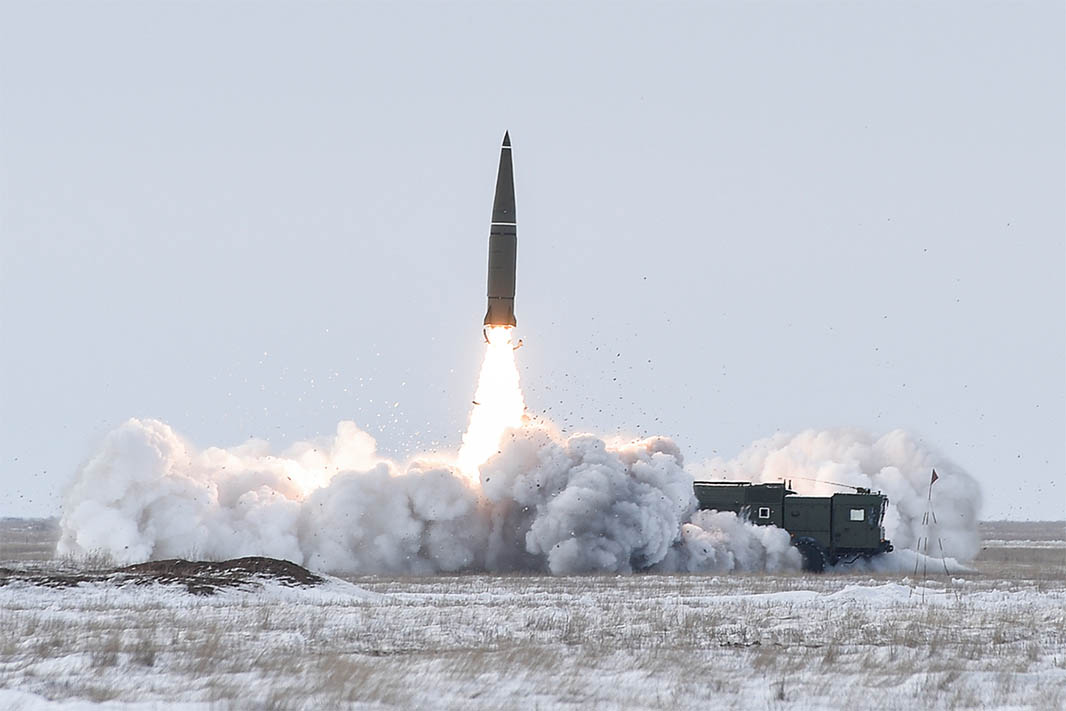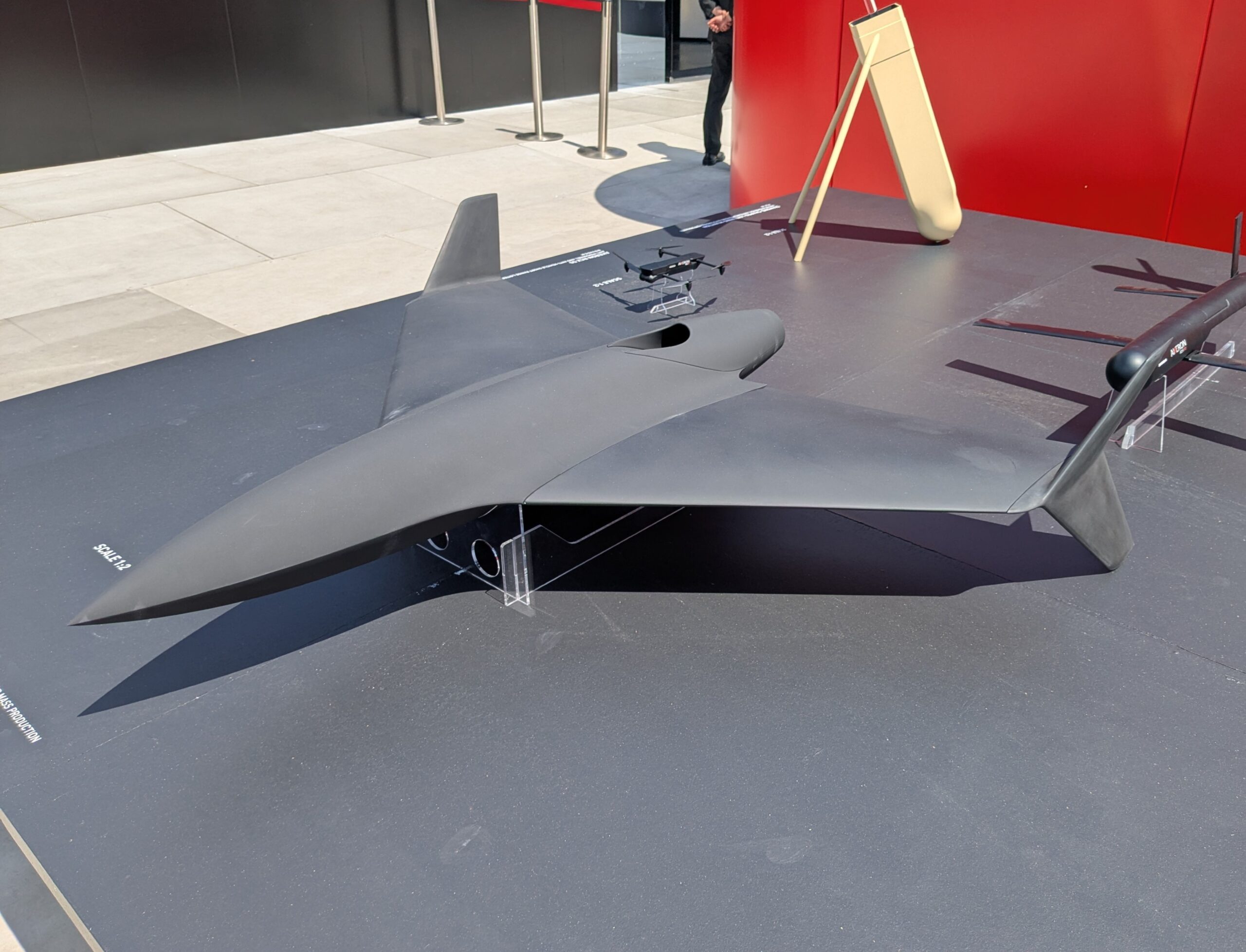The use of various types of ballistic missiles during recent and ongoing conflicts has highlighted their importance in future warfare, not only in terms of the need for participants to possess them in quantity, but also of being able to defend against them, effectively. Additionally, with repeated, foreboding threats by Russia over the past three years, alongside its changing nuclear doctrine, the need for the West to maintain effective ballistic missile capabilities is also growing in importance.
This article examines the appearance of one of the newest tactical ballistic missiles in the Russo-Ukraine conflict. It also touches on Ukraine’s efforts to develop its own tactical system as US ballistic missile supplies remain uncertain or depleted. The article moves from the tactical to strategic, offering a brief update on strategic ballistic missile developments of the land-based element of the US nuclear triad. Ballistic missile explosion
More ballistic missiles have been used in anger over the past three years than at any time since WW2, when over 3,200 of the world’s first tactical ballistic system, Germany’s V2, were launched by the Nazis, mainly against targets in the UK. Fast forward to today, and Russia’s ongoing war against Ukraine, has seen more than 10,000 Russian missiles launched against the defenders since the start of 2023, although some 800 Iskander-Ms short-range ballistic missiles (SRBMs) were used against Ukrainian targets in the early weeks of the war during the six-month period between April and September 2022. Add to the mix recent hostilities between Iran and Israel throughout June 2025, and the early-May tension and clashes between India and Pakistan, all of which involved the use of tactical battlefield ballistic missiles by one or both sides.
In Ukraine, while most of the missiles used, including Russia’s Iskander-Ms and US-supplied Army Tactical Missile Systems (ATACMS), have been around for years, on a more recent Russian development appeared for the first time.
Oreshnik
That new arrival is Russia’s Oreshnik, (ENG: Hazel Tree), an apparent intermediate-range ballistic missile (IRBM), with a range claimed as 5,500 km according to Russian sources on Telegram, with some other sources claiming a 5,000 km range. The missile is thought to be based on the RS-26 Rubezh intercontinental ballistic missile (ICBM), according to Pentagon sources. Unsurprisingly for a weapon of this class, the missile can reportedly exceed Mach 10, (12,300 kph), and reports from Ukraine’s Defence Intelligence Directorate, suggest it carries six multiple independently targetable re-entry vehicles (MIRVs), which re-enter the atmosphere at hypersonic speeds, and each MIRV thought to contain six submunitions of their own. It’s worth noting that the RS-26 programme was meant to have been discontinued at the end of 2017, though the US Defense Intelligence Agency reports suggest that either the programme has been re-started, or elements were retained and used to develop Oreshnik.
As for its first use in anger, the weapon’s opening appearance was in the skies over Ukraine on 21 November 2024, in what Moscow would cynically describe as a test; the missile was launched from Russia’s Astrakhan region, targeting the PA Pivdenmash factory in the city of Dnipro. According to Russian President Vladimir Putin, Oreshnik was employed in response to Ukrainian strikes on Russia with US and British missiles; both countries having previously lifted restrictions for their use against targets inside Russia. Indeed, Russian claims, prior to Oreshnik’s initial use, were that six ATACMS had been used against Russian targets, taking advantage of Washington’s new directives, thereby eliciting a ‘suitable’ response from the Russians. Interestingly, adhering to an old rule of warfare, US DoD general staff were alerted, pre-launch, by the Russians that the missile ‘test’ would take place. According to Ukraine’s Defence Intelligence Directorate, the missile launched against Dnipro came from the 4th Missile Test Range at Kapustin Yar and took just 15 minutes to cover 800 km before striking the town, and did, indeed, carry six MIRVs, each deploying six submunitions over their target. Ukrainian sources put the re-entry speed of the Oreshnik MIRVs as 3-4 km/s (Mach 8.7-11.6). Oreshnik numbers, likely low at this time, are apparently set to increase, following a June 2025 announcement by Vladimir Putin that the missile has now, supposedly, entered full-scale production, together with the threat to deploy them, during the second half of 2025, in Belarus. Whether this is purely posturing is yet to be seen.

Nevertheless, following the November 2024 Oreshnik attack and in line with its threatening political dimension, a mid-December 2024 TV appearance by Vladimir Putin, saw him explain the menacing changes to Russia’s nuclear doctrine, but also refer to Oreshnik as ‘the country’s new intermediate-range ballistic missile’, its use late November 2024, and suggest its capabilities could be further demonstrated if it were to be launched again against Ukrainian targets to see if Western-supplied air defence systems, such as, PATRIOT and SAMP-T, would be able to bring it down. It is worth mentioning in response to that challenge, that while the PATRIOT systems have been successful intercepting other Russian SRBMs and cruise missiles, drones, and aircraft, some defence analysts and certain Ukrainian sources consider it unlikely for either to be able to reliably intercept Oreshnik, due to the latter’s high speeds, flight parameters, and MIRVs, enabling it to effectively evade being engaged, unless multiple interceptors can be used to achieve success against each MIRV during the terminal phase of flight. The long range of Oreshnik also puts it at an advantage over these air defence systems, which were not intended for use against IRBM-class weapons; examples of more suitable alternatives for engaging such threats would include THAAD and SM-3.
Ukraine’s short-lived affair with ATACMS – so far…
Despite its heavy reliance on the US, European, and other allies for the supply of ammunition and equipment to defend itself since Russia’s 2022 invasion, Ukraine’s own defence industry has played the major role in keeping its defensive war effort going. Indeed, according to the Royal United Services Institute (RUSI), the US has accounted for about 20% of materiel supplied, Europe and other allied nations some 25%, while Ukraine’s own defence industry itself produces around 55% of the military hardware its forces rely on. However, amongst the US munitions supplied, though not in great numbers, has been the ATACMS tactical ballistic missile (TBM). Kyiv is said to have received ATACMS M39 Block I TBMs, with a range of 165 km, used in combat for the first time on 17 October 2023, while the longer-range M39A1 with bomblets and M48 with a unitary warhead (both 300 km range) were also reportedly supplied and used starting in March 2024.
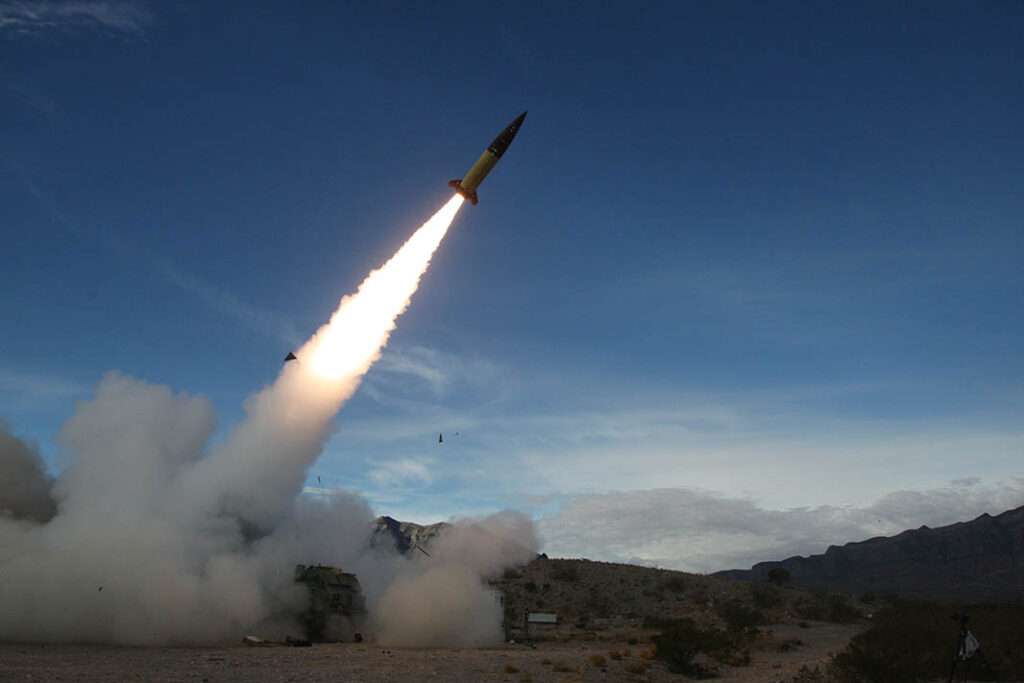
However, according to recent reports in Ukrainian and other media, all supplied variants of ATACMS to Ukraine ran out during the first few months of 2025. It still has launchers capable of launching them, but no missiles. That said, fewer than 40 of the ballistic systems were reportedly supplied by the US in the first place, with restrictions on using them against targets over the border in Russia only lifted by the Biden administration in November 2024. Since then, the few 300 km range ATACMS that remained were used effectively against high-value targets such as S-400 air defence systems and air fields.
…and Ukraine’s own ballistic missile foray
Add to this situation the uncertainty regarding ongoing US supplies and supply reliability, and it’s no wonder that Ukraine has, reportedly, developed its own domestically-designed TBM, which has already been used in anger and successfully targeted and, allegedly, destroyed a Russian command post at the missile’s maximum range of some 300 km, according to Ukraine’s UNITED24 Media.
Measuring slightly larger than ATACMS, the Hrim-2, also known as ‘Sapsan’, is capable of carrying a 400 kg payload and has already entered serial production, though at what scale is another question. The missile is designed by KB Pivdenne, and manufactured by PA Pivdenmash. Apparently, the missile’s development began not long after the invasion, in May 2022, with first test launch during mid-2024. A Ukrainian aviation expert quoted in UNITED24, Kostiantyn Kryvolap, suggested that future variants of the new Ukrainian missile might achieve extended range by trading warhead mass for an increased fuel capacity and modified engine, which further suggests that the full potential of Hrim-2 has yet to be revealed, as Ukraine joins an exclusive club of just ten other ballistic-missile-producing nations in the world.
Beyond Ukraine – replacing ATACMS: PrSM
While Ukraine continues to need additional supplies of ATACMS, the US is already moving forward with its replacement. The new Precision Strike Missile (PrSM) from Lockheed Martin is an SRBM now being fielded to replace ATACMS in the US Army. Its surface-to-surface, indirect, deep-fire capabilities are intended to be effective out to ranges of at least 499 km, with the system compatible for use with HIMARS and M270 MLRS platforms. Latest developments with the programme include the March 2025 US Army award to the company of a USD 4.94 billion indefinite delivery indefinite quantity (IDIQ) contract to produce additional PrSMs as and when required, with the production line able to respond flexibly to meet any growing or sudden demand. Carolyn Orzechowski, VP of Precision Fires Launchers and Missiles at Lockheed Martin, said the company was focused on advancing the production of PrSMs at speed and scale.

In mid-April 2025, Lockheed Martin and the US Army conducted a short-range, production-qualification test at the White Sands Missiles Range in New Mexico, to demonstrate platform integration and readiness, by launching a PrSM from an M270A2 MLRS launcher for the very first time. According to a Lockheed Martin press release, the Increment 1 missile was launched “at multiple targets, including a radar and rotary wing platform, engaging them with precise and lethal impact”. The test validating its performance and its integration with the M270A2 launcher. The missile’s ability to manoeuvre and maintain accuracy was also demonstrated during the short-range flight. Orzechowski added that although PrSM’s primary mission is long-range fires, the company also validates accuracy and reliability of the missile, even at the shortest distances, before handing it over to the Army. It is also worth noting that Northrop Grumman produces the solid rocket motor for the PrSM Increment 1.
Stateside strategic developments
Meanwhile, in the US – but this time at the strategic level – efforts continue to maintain the 50-year-old LGM-30 Minuteman III intercontinental ballistic missile (ICBM) nuclear deterrent without interruption. At the same time, progress is being made on its replacement: the LGM-35 Sentinel ICBM Ground Based Strategic Deterrent (GBSD) from Northrop Grumman. This is intended to remain in service for at least 50 years once it enters operational use.
In the meantime, Minuteman’s capabilities have to be maintained to ensure a full and seamless transition of the nuclear deterrence between the two systems. Currently, some 400 Minuteman IIIs remain at readiness, all armed with a single warhead, either the W78 (335 kt) or W87 (300kt) warheads, and located among some 450 silos dotted around thousands of square kilometres across several states – a notable reduction compared to the roughly the 1,000 Minuteman I, II, and III incarnations deployed during the 1970s. With the New START treaty due to expire in 2026, the US is planning to field Minuteman III ICBMs with three warheads again. To this end, a test launch of a three-warhead Minuteman III was conducted from Vandenberg Space Force Base (SFB) in California, on 5 November 2024.
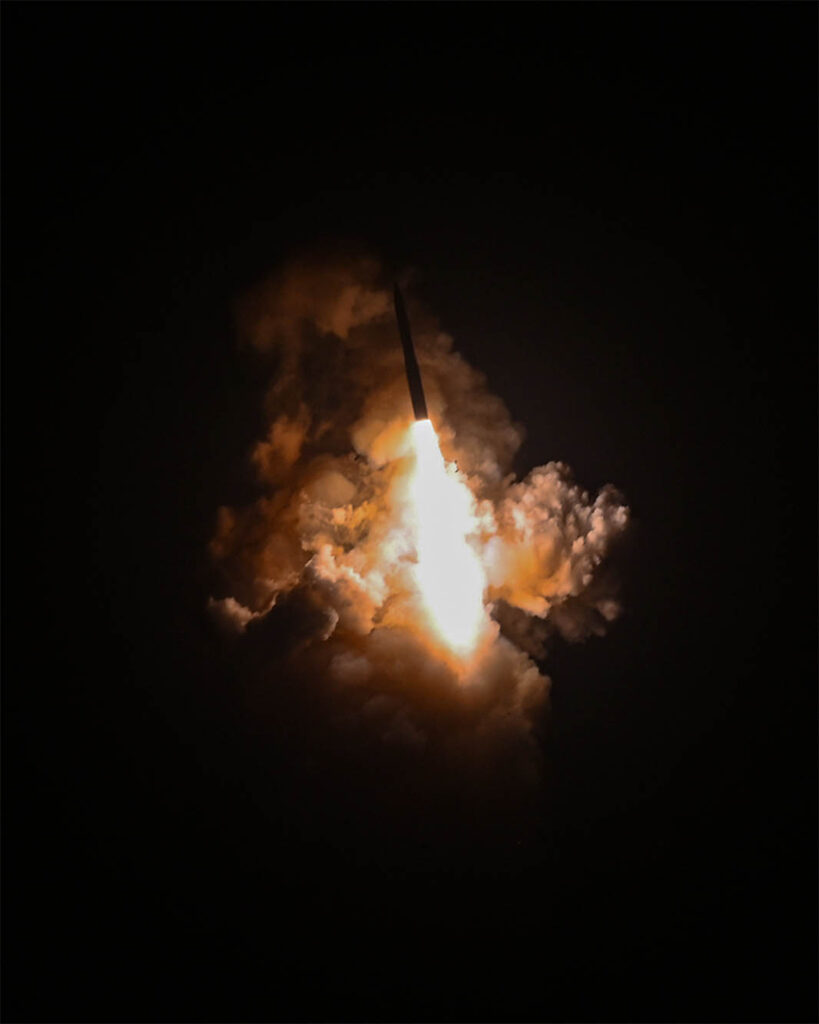
Minuteman IIIs most recently proved their continued operational readiness on 21 May 2025, when US Air Force Global Strike Command (AFGSC) conducted a test launch, from Vandenberg SFB, of an unarmed missile carrying a single-payload Mk-21 high-fidelity re-entry vehicle (RV); these are designed to carry the W87 warhead. The test launch was routine and long-planned, with Vandenberg the main testing ground for the AFGSC’s total nuclear deterrent ecosystem; such events are designed to evaluate all aspects of the system’s continued effectiveness, reliability, safety, and security. According to AFGSC, the Minuteman III ICBM’s RV travelled some 7,780 km (4,200 NM) westwards across the Pacific Ocean to the Ronald Reagan ballistic missile defence test site on the Kwajalein Atoll in the Marshall Islands. Part of the US Army Space and Missile Defence Command, the test site is equipped with a range of sensors, including high-fidelity radar and optical systems, which gather telemetry data during the missile’s terminal phase, the analysis of which helps determine overall system performance. The test launch was conducted by Vandenberg’s 337th Test and Evaluation Group; its only function is the continual test and evaluation of the US’s ICBM force to ensure it remains at a complete state of readiness at all times. This same unit will eventually perform the identical functions for the Sentinel Programme.
Sentinel cost overruns fund an Air Force One, of sorts
One of the most curious aspects of the latest LGM-35A Sentinel programme has been a decision to reallocate excess funds from the programme’s 2024 budget to the refurbishment project to convert the Boeing 747 donated by Qatar to the Trump Administration, into an interim Air Force One. Reassuringly, Secretary of the Air Force, Troy Meink, is reported to have confirmed Sentinel as fully funded, despite the reallocation of funds, which was only made possible by the programme’s restructuring and a full cost-overrun review.
Indeed, one of the unforeseen additional infrastructure costs has been in relation to silo construction; where previous costings had budgeted the programme based on 450 existing Minuteman III silos simply being refurbished and re-used for Sentinel, it eventually became clear that completely new silos would have to be built at considerable additional costs in order to accommodate the Sentinel missiles. The programme was originally expected to cost USD 77.7 billion, but had been on course to reach a staggering USD 160 billion. This initiated the Nunn-McCurdy Act in January 2024, requiring the Department of Defense (DoD) to report the programme’s expected cost overruns to Congress; a breach or critical breach of the act occurs when a programme’s unit cost exceeds certain thresholds, beyond which it’s down to the Secretary of Defense to decide whether to close a programme down, or keep it going if it’s vital to national security, which, in the case of Sentinel, it is. So, restructuring and reallocations took place, the programme continues, even as the President’s aircraft receives a makeover boosted by some unexpected ICBM funding. Nevertheless, Sentinel is still, according to the Pentagon, set to cost almost USD 141 billion by the time it’s operational. Each missile alone is now expected to cost USD 162 million.
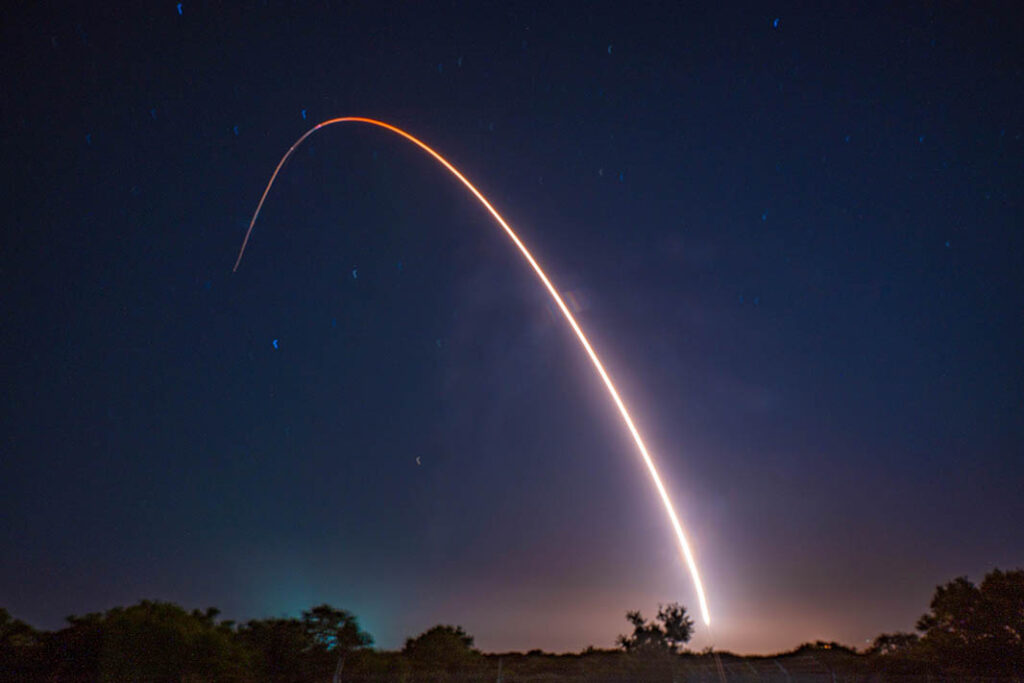
Around the same timeframe as all this was going on, the Air Force Nuclear Weapons Centre (AFNWC), together with Sentinel programme prime contractor, Northrop Grumman, and sub-contractor, Aerojet Rocketdyne, conducted a static-fire test of the LGM-35A Sentinel ICBM’s third-stage solid rocket motor, on 16 March 2024, at the Arnold AFB Arnold Engineering Development Complex in Tennessee, the third such test of Sentinel’s three-stage propulsion system. In January 2024, under the terms of Northrop Grumman’s engineering, manufacturing, and development (EMD) design contract for Sentinel, the second-stage solid rocket motor had already been tested successfully at the same location in a vacuum chamber to simulate the environmental conditions the motor would experience during high-altitude and space flight. The company is designing and producing stages one and two of the three-stage Sentinel missile, and with these early-2024 tests successfully completed, has now moved forward with the USAF to qualification testing, with the data from the rocket motor tests informing ongoing modelling and designs. The first-stage solid rocket motor static-fire and hypersonic wind-tunnel tests were previously conducted under the same EMD contract.
Some 634 Sentinel ICBMs are slated to be procured by the USAF, with a further 25 acquired to enable live training test firings with inert warheads. 400 of the missile inventory are to be deployed in operational readiness in new silos, while the remaining 234 will presumably be kept in storage. The programme also involves modernising 450 silos and 600 facilities among the wider Sentinel ecosystem of command and control (C2) centres, monitoring and administration facilities spread over some 100,000 km2, across several states: California, Colorado, Nebraska, North Dakota, Montana, and Wyoming.
A warhead for the future
While Minuteman III ICBMs are equipped, as mentioned earlier, with the W87 warhead, a W87-1 Modification Programme has been in play to reinvigorate and transform the US’s nuclear warhead production complex, which has deteriorated since the Cold War, and to produce the new warhead that will eventually equip Sentinel ICBMs. The programme will ensure the US’s Nuclear Security Enterprise (NSE) once again becomes a turnkey producer of all of the components required to make a modern nuclear warhead. In fact, the W87-1 will be the first 100% newly manufactured nuclear warhead to enter the US stockpile since the end of the Cold War. On the path to make that happen, the US Department of Energy’s National Nuclear Security Administration (NNSA) announced a milestone, in October 2024, that it had completed and ‘diamond-stamped’ the first production unit (FPU) of a Plutonium pit for the new W87-1 warhead. Plutonium pits are a necessary component of each US nuclear warhead and the NNSA is currently rebuilding the nation’s capability to manufacture them at the rate of at least 80 pits per year – hundreds were made each year during the Cold War, but production ceased when the Berlin Wall came down in 1989 and the Cold War ended.

The NNSA said that “achieving an FPU for the W87-1 pit is an important milestone for the US’s nuclear weapon stockpile modernisation”, particularly as the new warhead supports the Sentinel ICBM programme. Its diamond stamping means that the FPU pit meets all requirements to join the US nuclear stockpile at ‘war-reserve’ quality. To reach this milestone, scientists from Lawrence Livermore National Laboratory, Los Alamos National Laboratory (LANL), the Kansas City National Security Campus (KCNSC), and the Nevada National Security Site worked with NNSA over eight years, with the Livermore Laboratory responsible for pit design, and eventual pit manufacturing completed at LANL.
According to the NNSA, consistent Plutonium pit production is vital to the nuclear stockpile; a target capacity to reach 30 pits per year at LANL is the current aim, though by an unspecified timeframe, with equipment installation and other facility improvements still required to ensure an “increasingly dependable production capability”. Meanwhile, the Savannah River Plutonium Processing Facility at the Savannah River Site in South Carolina is under construction and, as part of the NNSA’s nuclear weapons complex, is slated to reach a 50 pits-per-year capacity “in the mid-2030s”, the NNSA said.
Whether this rate of pit production meets Sentinel’s intended in-service dates and requirements remains to be seen, as the new ICBM is expected to begin replacing Minuteman IIIs in 2029, with an initial operational capability set for 2030. With much at stake, it’s probably safe to say someone, somewhere, is coordinating this essential correlation.
Tim Guest
Author: Tim Guest is a long-time defence journalist, UK Correspondent for ESD, and a former officer in the UK’s Royal Artillery.
